From methional to fried chicken Understand article
Methional played centre stage at the recent Second International Contest for Note by Note Cooking. The challenge: to make dishes containing only methional and ‘pure’ compounds such as milk proteins, alcohols, amino acids and flavour chemicals, and, ideally, no plant tissues, meat, fish or eggs
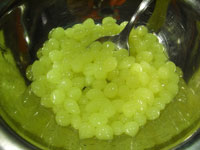
liquids into pearls using soft
gels is a popular technique in
molecular gastronomy.
Image courtesy of Image in the
public domain/ Wikimedia
Drain a pan of boiled potatoes and the steam that rushes past your face brings with it an unmistakeable earthy smell, with an underlying hint of bacon.

Methional is an organic
compound; its formula is
CH3SCH2CH2CHO. When
pure and under ordinary
conditions, it is a colourless
liquid with a strong smell of
cooked potatoes with bacon
notes.
Image courtesy of Nicola Graf
The chemical hitting your nose’s odour receptors is called methional, and it is also found in asparagus, beer, cheddar cheese and tomatoes.
The simple, sulfur-containing derivative from the amino acid methionine played centre stage at the recent Second International Contest for Note by Note Cookingw1 in Paris, France. The challenge: to make up to three dishes, all containing only methional and other ‘pure’ compounds such as milk proteins, alcohols, amino acids and flavour chemicals. Extra points were awarded for dishes without plant tissues, meat, fish and eggs.
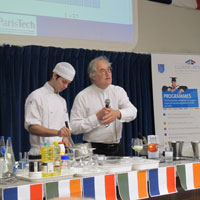
Institute of Technology, with
a student demonstrating how
to achieve a greater volume
when whipping egg whites.
Image courtesy of the Dublin
Institute of Technology/
Wikimedia
The contest was organised by Hervé Thisw2, a physical chemist from the French National Institute for Agricultural Research, who came up with the concept of ‘note by note’ cooking. In 1988, together with the late Oxford physicist Nicholas Kurti, Dr This laid claim to the scientific discipline of molecular gastronomy, which has a clear goal to hunt out the mechanisms underlying cooking, tasting and eating food. Chemistry and physics are at its core.
The field spawned a generation of inventive chefs who brought lab equipment, from rotary evaporators to water baths, into the kitchen. Liquid nitrogen hit the culinary scene, as did a host of tricks with gelling agents, producing soft gel pearls with a liquid core packed full of flavour.
‘Note by note’ cuisine?

Formula of L-Methionine.
Image courtesy of Benjah-
bmm27/Wikimedia Commons
Initially intended to improve food, ‘note by note’ cuisine soon morphed to acquire the ambitious goal of making dishes entirely from compounds, Hervé This says. “I don’t want to recreate anything. The proposal with ‘note by note’ is to create new food.” He equates the approach with using a synthesiser to make music. “With a synthesiser you can make any music. With ‘note by note’ cuisine you can make any food.”
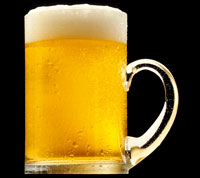
Image in the public domain/
NIH
Dr This envisages a time when we will routinely assemble food from ingredients taken from jars and bottles in our kitchens. “‘Note by note’ will be the future,” he insists. “If the public wants and needs it, it will happen.”
Importantly, he sees ‘note by note’ as a solution to the inevitable food crisis that lies ahead as the world’s population continues to expand.
One of the key advantages of this type is cuisine is its ability to cut transport needs. Dr This takes the example of tomatoes. When fresh, the fruit is heavy and water-laden.
Why transport the water, asks Dr This. Instead, necessary nutrients and flavours could be extracted at the farm site and reintroduced when the tomatoes are needed. He compares this process to transporting cheese instead of milk, or wine instead of grapes.
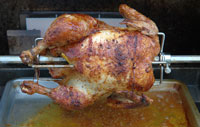
year’s contest for Note by
Note Cooking was a variation
on roast chicken.
Image courtesy of JMSchneid/
Wikimedia
Dr This is almost evangelical about ‘note by note’ cuisine, and has been busy touring the USA and Europe to spread the word. “The contest is one of many pieces to implement ‘note by note’ cooking for everybody,” he says. This year, it was a “big success”.
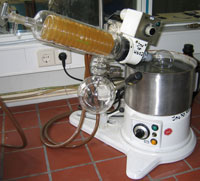
preparation of distillates and
extracts in the kitchen of a
restaurant.
Image in the public domain/
Wikimedia
Seventy-three contestants battled it out for five prizes in different categories. An undergraduate team studying molecular gastronomy at the Dublin Institute of Technology, Ireland, won the student prize with its novel roast chicken creationw3. This was developed in response to a specific challenge to make a dish that is neither extraordinary nor extravagant yet evokes memories. Their creation consisted of a wafer or tuile of roast chicken, with a smattering of accompaniments. They made powdered ‘potato’ by mixing a methional solution in oil with maltodextrin, citric acid and salt, and turned it into a potato meringue.
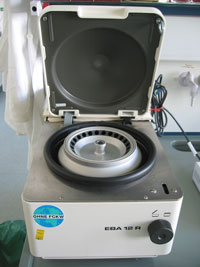
making a noteworthy
entrance into restaurants’
kitchens.
Image in the public domain/
Wikimedia
This sat alongside rosemary caviar made from sodium alginate, and a roasted carrot tuile made by mixing powdered carrot with maltodextrin, sugar, a gel and water. The resulting gel layer was then dehydrated until it became crispy.
Next year’s contest will focus on plant protein, Dr This says. With demand for meat soaring across the globe, creating foods from plant proteins will become increasingly important, he says.
For Dr This, part of the challenge is to persuade companies to sell ingredients such as methional directly to the public. As it happens, methional can already be purchased from lab suppliers for industry use. One, Sigma Aldrich, bills methional as being “toothsome” and able to complement many savoury flavours. At very low levels it can add an “appetising, cooked quality to fruits like apple, pineapple and pear”.
So how does methional hit our senses?
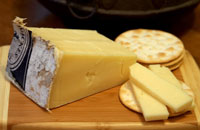
food that contains methional.
Image in the public domain/Jon
Sullivan
Only about one fifth of flavour perception comes from the tongue’s taste buds; most of the rest comes from smell. When we chew food, our mouths pump volatile molecules to the nose where they are met by hundreds of different odour receptors.
Each receptor consists of a protein specially designed to create a pocket for odour molecules to sit in. When a molecule activates a receptor, it triggers an electrical signal that travels to the brain.
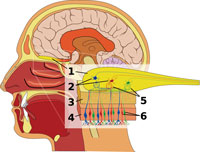
Overview of the human
olfactory system. 1: Olfactory
bulb 2: Mitral cells 3: Bone
4: Nasal epithelium
5: Glomerulus 6: Olfactory
receptor neurons.
Image courtesy of Ignacio
Icke/Wikimedia
In 2004, US scientists Richard Axel and Linda Buckw4 were awarded a Nobel prize in physiology or medicine for their discovery of odour receptors and the organisation of the olfactory system. They discovered a large family of about 1000 different genes that produce an equivalent number of types of olfactory receptors. These receptors are found in receptor cells.
Each receptor cell contains only one type of odour receptor and each receptor can detect only a limited number of smells. The cells send signals directly to a region of the brain called the olfactory bulb, and on to other parts. Information from different receptors combines to create an odour pattern.
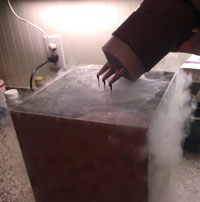
Image courtesy of Scott
Beardsley/Wikimedia
Gordon Shepherd, a neuroscientist at Yale School of Medicine, USA, has worked on the olfactory bulb since the 1960s. He calls the process of how the brain creates flavour ‘neurogastronomy’. “Much of our brain power is actually used to create flavours and everything that goes with the flavours – memories, emotions and the language that we use to describe the flavours,” he says. He works on ‘odour images’ in the brain, which are processed at the highest level, where perception occurs.
“The more we understand about how the brain creates flavour, the more it will help us to understand how to encourage healthy diets,” he says.
Web References
- w1 – Read more about the 2nd International Contest for Note by Note Cooking in Paris, France.
- w2 – Hervé This has gathered his work and all sorts of information related to molecular gastronomy online, including material for teachers and ready-made lesson plans on his blog. He also has several other blogs where he writes about:
- w3 – Read this article from New Scientist provides a good explanation of ‘note by note’ cooking, and mentions the winners of this year’s contest.
- w4 – Learn more about the Nobel Prize awarded to Richard Axel and Linda Buck.
Resources
- Read more about the AgroParisTech’s International Centre for Molecular Gastronomy that was opened in June 2014; its director is Hervé This.
Review
Odours play an important part in memory and can be strongly linked to experiences. This is due to the olfactory receptors. This is the key idea in making ‘foods’ that bring the gastronomic experience without the primary animal and plant protein present. This article could be used to stimulate discussion on the world food shortage and how alternatives could be manufactured. How would the manufacturers ensure that nutritional guidelines are met? Students could investigate food labels, research the key chemicals that produce particular flavours, and study how flavourings are manufactured for foods – for example, how are potato crisp flavours made? The concepts and science of molecular gastronomy could be discussed, as some chefs are now using scientific techniques to advance food preparation and presentation.
Dr Shelley Goodman, UK





